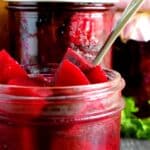
Dad's Canned Pickled Beets
Servings: 36 servings
Calories: 99kcal
Preserving a fall harvest is an experience like no other, and every home chef should try canning at least once. Dad's Canned Pickled Beets is the perfect place to start, because their very easy to can. No fancy equipment needed for this one! They're sweet, vinegary, and fork-tender; these beets will keep you smiling all winter long!
Print Recipe
Ingredients
- 10 pounds beets, boiled until fork tender, cooled and skin removed (see notes)
- 2 cups white vinegar
- 2 cups water
- 2 cups sugar
Instructions
- Once the beets are boiled and cooled, follow the peeling and cutting directions in the notes section.
- Next, prepare the brine by adding the vinegar, water, and sugar to a sauce pan. Over medium heat, bring the mixture to a boil. Stir occasionally to help dissolve the sugar. Once boiling, reduce heat to simmer.
- In the meantime, prepare the jars by following the instructions in the notes section.
- Use a canning funnel to fill the jars with the prepared beets. A canning funnel will help to keep the rim of the jars clean which will help to guarantee a better seal.
- Ladle in the brine, leaving at least 1/4-1/2 inch head space. Remove the funnel and place a warmed, sterilized seal on the jar, followed by a ring. Tighten just until snug.
- Using a jar lifter, place the filled jars back into the large pot of boiling water. See notes. Bring back to a boil. Once the water is boiling, start a timer for 20 minutes.
- Using a jar lifter, carefully remove the jars and place on a kitchen towel where they will not be disturbed. As the jars cool, you’ll hear a popping sound. This is the hot liquid and air in the jar cooling down and contracting. This will create an air-tight seal and will allow you to store your beets for future consumption.
- For best results, I recommend allowing the jars to sit undisturbed for at least 12 hours. With a damp cloth, wipe down the jars, re-tighten the lids, and store in a dark, cool place. These jarred beets will last for 12-18 months. Lastly, if you notice that a jar has not properly sealed, simply refrigerate that particular jar, and eat them within 5-7 days.
Notes
One serving is about 1/4 cup.
To peel the beets without a knife, using only your fingers as a tool, apply a mild pressure to the skin of the beet and push to remove the skin. This takes some patience, depending on how many beets you’ve cooked, but you want to avoid cutting the flesh of the beet away with a knife. Once done, slice off what is remaining of the stem and the tail, and cut the beets any way you desire.
To sterilize your jars, wash the jars well in hot, soapy water. Rinse the soap off in hot running water and place the clean jars into a large pot of water. Bring to a boil and allow the jars to sit in the boiling water, fully submerged, for at least 5 minutes. Avoid contact with the inside of the jar and the rim. To sterilize the seals and lids, wash them as you did the jars, and boil water in your kettle. Pour the boiled water into a clean bowl and drop the seals and lids into the water. Be sure the lids and seals and completely submerged.
Once I remove the jars from the boiling water, I usually place them rim side up on a baking sheet and leave them in my oven that is set to 200 degrees. This will keep the jars just warm enough until you're ready to fill them.
Be sure the jars are not touching the bottom of the pot. This might cause the jar to break. I use a circular cooling rack that fits right into the bottom of my pot. (If you have a canning pot with a wire jar rack, then you won’t need to worry about this.)
Nutrition
Calories: 99kcal | Carbohydrates: 23g | Protein: 2g | Sodium: 99mg | Potassium: 409mg | Fiber: 3g | Sugar: 19g | Vitamin A: 40IU | Vitamin C: 6.2mg | Calcium: 21mg | Iron: 1mg